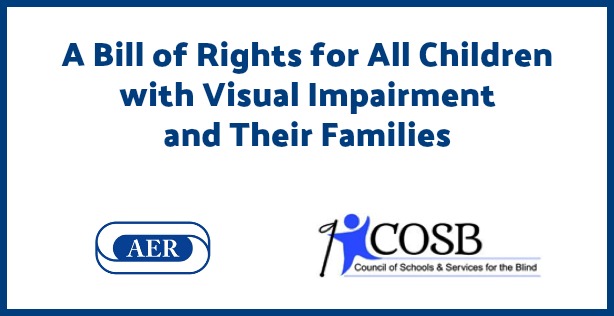
A Bill of Rights for All Children with Visual Impairment and Their Families
A Bill of Rights for All Children with Visual Impairment and their Families was created by COSB and AER.
The leaders of Council of Schools & Services for the Blind (COSB) and the Association for the Education and Rehabilitation of the Blind and Visually Impaired (AER) have teamed up to develop a clear, concise “Bill of Rights” as a resource to inform parents, professionals and legislators on the basic educational rights of all children who are blind or visually impaired. The authors hope that this resource will be widely distributed and endorsed (formally or informally) by interested individuals and organizations. It is not fully inclusive of all rights; it is a starting point for teams when planning individualized programs for children with visual impairments.
Preamble
In addition to numerous educational principles that have been proven to be beneficial for children with visual impairment, all the provisions of what constitutes a “Free and Appropriate Public Education” under the federal Individuals with Disabilities Education Act of 1990 shall be assumed along with this bill of rights.
Bill of Rights
- Children with all levels of visual impairment (including those with multiple disabilities and those who are DeafBlind) have a right to early intervention/instruction provided by highly trained and qualified teachers of students with visual impairment and certified orientation and mobility specialists, that is timely, ambitious, and results in the highest possible achievement for each child.
- Children with visual impairment have the right to a functional vision evaluation and a learning media assessment by highly trained and qualified teachers of students with visual impairment to determine appropriate services following the initial clinical eye exam.
- Parents/guardians of children with visual impairment have the right to assistance in interpreting the educational implications of the diagnosed visual impairment that is provided by highly trained and qualified teachers of students with visual impairment and certified mobility specialists and the right to seek assistance from regional/national agencies (including consumer advocacy organizations) that can help them make informed decisions on behalf of their child.
- As required in the Individuals with Disabilities Education Act “in the case of a child who is blind or visually impaired, the Individualized Education Program (IEP) Team must provide for instruction in braille and the use of braille unless the IEP Team determines, after an evaluation of the child’s reading and writing skills, needs, and appropriate reading and writing media (including an evaluation of the child’s future needs for instruction in braille or the use of braille), that instruction in braille or the use of braille is not appropriate for the child.” Appropriate reading and writing media are determined by conducting a learning media assessment.
- Children and families have the right to be fully informed about the “Expanded Core Curriculum” of skills unique to students with visual impairment, which includes: compensatory skills, orientation and mobility, social interaction skills, independent living skills, recreation and leisure skills, career education, assistive technology, sensory efficiency skills, and self-determination.
- Children have the right to assessment and instruction, in school and in their communities, in every area of the Expanded Core Curriculum that is deemed appropriate by the educational team and includes the parents/guardians as the primary decision makers and includes the student when appropriate. The Expanded Core Curriculum is equal in importance to the standard academic curriculum and will not be overlooked in the educational plan.
- Children have the right to receive school materials that are accessible, in the preferred format and at the same time as their sighted peers. Children have an absolute right to testing procedures and instruments that are fair and accessible, that take into consideration the results of the functional vision evaluation, and include all accommodations identified in the IEP.
- It is the right of children and families for a full range of educational placement settings to be discussed at IEP meetings, including the variety of unique programs and options offered in specialized schools/services for children who are visually impaired. A specialized school may offer the best opportunity for achievement and be the “least restrictive environment” for some children
- All children with a visual impairment have the right to teams that enthusiastically assist them in preparing for transition to independence and adulthood.
- Children with visual impairment, including those with multiple disabilities and DeafBlindness, have the right to be perceived and treated as equal, active, and contributing members of their communities, classrooms, and schools. As with all children, their engagement through belonging increases the collective value of each setting within which they participate.
The rights listed in this document consist of a combination of legal rights, ethical rights, and human rights. This document exists as a resource for students, parents, and professionals. The authors hope that this resource will be widely distributed and endorsed (formally or informally) by interested individuals and organizations. It is not fully inclusive of all rights; it is a starting point for teams when planning individualized programs for children with visual impairments.
This resource is the result of a joint project between the leaders of the Association for the Education and Rehabilitation of the Blind and Visually Impaired (AER) and the Council of Schools and Services for the Blind (COSB).
